|

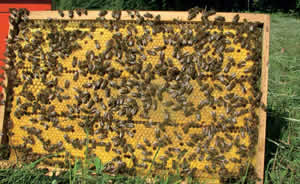 Introduction Introduction
In 1879, August Pollmann described and named the bees he
obtained from Carniola as the subspecies Apis mellifera carnica, known also as the Carniolan bee or the Krainer Biene. Technical improvements
and modernizations in beekeeping as well as
the spread of reared stock in the second half of the 19th and in
the 20th century further consolidated the identity and reputation of the Carniolan bee in Europe. Alongside the recognition and description of the biological characteristics of the western
honey bee, important progress was also achieved in commerce.
In 1866, Emil Rothschütz, a German immigrant, started selling bees,
creating proper conditions for an important element of beekeeping: “commercial bee breeding.” In addition to Rothschütz, many other beekeepers traded in bees.
Historical Overview
In the second half of the 18th century, beekeeping was highly
developed in Carniola thanks to the Enlightenment activities of Peter Pavel Glavar (1721–1784) and the activities of Anton Janša (1734–1773) in Vienna.
Bees were bred commercially by Barron Filip Rothschütz from
Višnja Gora in Lower Carniola; in 1858, he sold his first bees to Eichstadt, Germany.
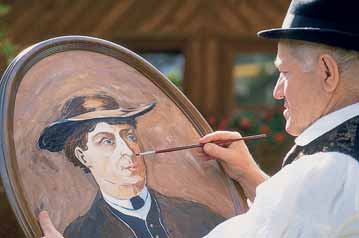 In 1879, August Pollmann described a new subspecies or race,
bearing the Latin name Apis mellifera carnica, but also called the Carniolan bee or the Krainer Biene. In 1879, August Pollmann described a new subspecies or race,
bearing the Latin name Apis mellifera carnica, but also called the Carniolan bee or the Krainer Biene.
The most prominent bee merchants were the following:
Emil
Rothschütz (1836–1909),
Mihael Ambrožič (1846–1904),
and Jan Strgar (1881–1955).
Many other beekeepers specialized in selling bees, primarily
trading in swarms.
After the First World War, the bee trade experienced a decline.
In 1984, the Slovenian Service for Carniolan Bee Selection was established
as part of the Agricultural Institute of Slovenia.
The service was responsible for improving the quality and scale of
queen rearing. Financial support was allocated for this purpose from the Ministry of Agriculture, Forestry, and Food.
All bee imports are subject to approval from the Ministry of
Agriculture, Forestry, and Food. With ongoing selection and intensive colony and queen rearing, Slovenia has managed to
preserve the indigenous population of the Carniolan bee.
In declaration no. 42 of the European Union Association Agreement,
the Republic of Slovenia ensures the implementation of all suitable normative measures (Animal Husbandry Act;
Official Journal of the Republic of Slovenia, nos. 18/2002, 110/2002 (8/2003
– rev.), 110/2002, and 45/2004) for the preservation of the indigenous bee race Apis mellifera carnica.
In 2004, the Slovenian Beekeepers’ Association obtained the
status of a recognized bee breeders’ association. In Slovenia, beekeepers are allowed to keep only the Carniolan bee Apis mellifera carnica, a subspecies of the western honey bee Apis
mellifera.
Slovenia is the original homeland of the Carniolan bee (Apis
mellifera carnica). Only bees with established typical characteristics
may be entered in the Pure-Line Carniolan Bee Breeding
Register.
Morphological characteristics
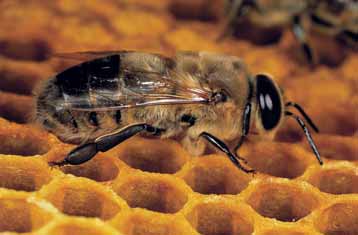 Queen: Queen:
• Light brown, leathery brown, or dark;
• A well-developed, resistant thorax and a long, pointed abdomen.
Worker bee:
• Medium-sized, thin, generally gray, long legs;
• The abdomen is pointed and dark, the first wide lateral abdominal
segment may exhibit leathery brown spots or patches, the
first abdominal segment may be entirely leathery brown;
• The tomentum is gray to yellowish gray, wide, and very distinct;
• The hairs of the fifth abdominal segment are thick and short
(0.25–0.35 mm);
• The cubital index is 2.7 (2.4–3.0);
• The proboscis is 6.4 to 6.8 mm long.
Drone:
• The abdomen is dark, never yellow;
• The hairs are gray to grayish brown;
• The cubital index is 2.0 (1.8–2.3).
Ethological characteristics of the Carniolan bee:
• Very docile, rarely stings;
• Calmly sits on the honeycomb;
• Renowned for its high yield;
• Does not fly into foreign hives;
• Over-winters in relatively small colonies and consumes moderate
amounts of stored food;
• Exceptionally intensive spring development, good laying;
• Inclined to swarm.
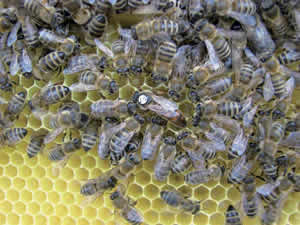 The Carniolan bee has specific biometric characteristics. The
Julian Alps area, as well as the eastern border area of Slovenia,
is
home to several species of the western honeybee. It is no wonder
that crossbreeds are not uncommon, especially between
Apis mellifera ligustica and A. mellifera carnica. Even in the habitat
of the indigenous Carniolan bee (A. mellifera carnica), local varieties
exist. These have been largely defined by Jože Rihar and Janez
Poklukar on the basis of their research. Based on beekeepers’
experience, a firm grounding in local varieties of the Carniolan
bee is also very important for practical beekeeping. Their most
frequent characteristics are: intensity of spring development, the ability
to gather nectar in various geographical and climatic environments, maintaining the number of bees in the colony during the summer, the post-foraging period, and the ability to survive long winters. The Carniolan bee has specific biometric characteristics. The
Julian Alps area, as well as the eastern border area of Slovenia,
is
home to several species of the western honeybee. It is no wonder
that crossbreeds are not uncommon, especially between
Apis mellifera ligustica and A. mellifera carnica. Even in the habitat
of the indigenous Carniolan bee (A. mellifera carnica), local varieties
exist. These have been largely defined by Jože Rihar and Janez
Poklukar on the basis of their research. Based on beekeepers’
experience, a firm grounding in local varieties of the Carniolan
bee is also very important for practical beekeeping. Their most
frequent characteristics are: intensity of spring development, the ability
to gather nectar in various geographical and climatic environments, maintaining the number of bees in the colony during the summer, the post-foraging period, and the ability to survive long winters.
An important goal of the Carniolan Bee Breeding Program is preserving
the population variability of the Carniolan bee in Slovenia.
This is a special mission and obligation incumbent upon all
beekeepers. The need to preserve natural varieties that are not the product of human selection must be emphasized.
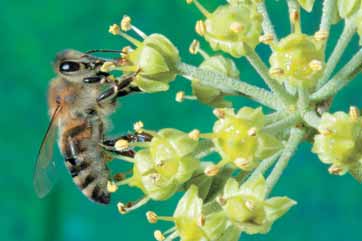 The Carniolan Bee Breeding Program The Carniolan Bee Breeding Program
Tasks envisaged for attaining the Carniolan bee breeding
goals include procedures for evaluating their characteristics, testing
their economically important and other characteristics, estimating
the breeding value of reared bees, and selection measures. Moreover,
the program deals with health issues and other beekeeping activities
that influence the quality of the reared pure-line stock.
Organizational and technical work is directed and conducted by
the recognized bee breeders’ association (the PRO; the Slovenian Beekeepers’ Association holds this status) and the second recognized beekeeping association (the DPO; that is, the Agricultural Institute of Slovenia). These two most important beekeeping organizations in Slovenia are contractually linked. The PRO unites beekeepers that are also its members, but have acquired certain rights and obligations.
The breeders’ association collects data for entry into the Pure-Line
Carniolan Bee Breeding Register. The approved queen-rearing station forwards this data to the PRO, which in turn issues zootechnical certificates.
Carniolan Bee Breeding Goals:
• Preservation of racial purity;
• Preservation of variability in the population;
• Increased calmness in the bees;
• Reduction of swarming;
• Increase in the number of bees in colonies;
• Strengthening bees’ productive qualities (honey yield);
• Strengthening the bees’ resistance to diseases. Planned activities for achieving the breeding goals:
• Primary selection (conducted by all bee farms);
• Rearing work (organized as part of all approved queen-breeding stations);
• Rearing pure-line queens.
Beekeepers’ Activities
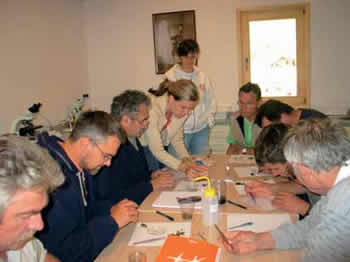 As part of the Carniolan Bee Breeding Program, primary selection
is conducted by all beekeepers. Primary selection refers to monitoring the characteristics of bee colonies and, when necessary, replacing the queen at one’s own bee farm. This is a prerequisite for successful maintenance of the desired quality of the Carniolan bee population. Primary selection ensures the preservation of Carniolan bee characteristics attained through development in different geographic environments. All beekeepers that decide to carry out primary selection actively participate in the program for ensuring and maintaining the purity of the bee race. As part of the Carniolan Bee Breeding Program, primary selection
is conducted by all beekeepers. Primary selection refers to monitoring the characteristics of bee colonies and, when necessary, replacing the queen at one’s own bee farm. This is a prerequisite for successful maintenance of the desired quality of the Carniolan bee population. Primary selection ensures the preservation of Carniolan bee characteristics attained through development in different geographic environments. All beekeepers that decide to carry out primary selection actively participate in the program for ensuring and maintaining the purity of the bee race.
Monitoring the Characteristics of Bee
Colonies and Requeening: Primary Selection
The beekeeper monitors the racial characteristics of worker
bees in individual colonies and notes the findings on a hive record
card. At least three evaluations per year are recommended.
The first inspection should be carried out during dandelion blossoming, the
second during black locust blossoming, and the third during chestnut blossoming. The beekeeper simultaneously inspects all the colonies in the hive.
Bee colonies with worker bees whose first abdominal segments
(or more segments) are yellow must be excluded from further rearing. Orange and leathery brown colors on the sides of the first segment are acceptable. The beekeeper prepares the breeding stock to use for rearing queens from the colonies whose characteristics ranked them in the upper (or highest marked) third. When the queen cells are ripe and the queens are mated, he replaces the old queens with new, younger ones in the colonies planned for requeening. Because the beekeeper rears queens at home, these queens come from the same bee farm. Sometimes the beekeeper provides some new genetic material from the same geographical environment.
Ensuring the Preservation of Required Diversity
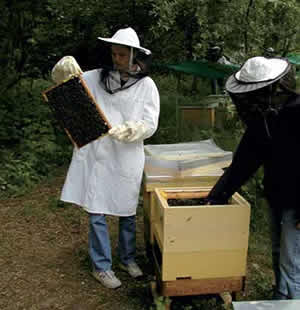 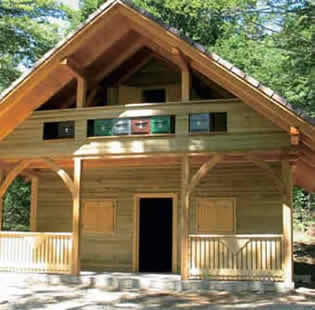
To ensure the preservation of a race with all its variability, the
dispersal of a population is paramount. The preservation of bees in individual geographic areas is incumbent upon all beekeepers.
Measures to encourage and preserve an adequate quality of
bee stock (including primary selection at all bee farms, as well as the intensive rearing of bees and professional work at isolated pure-line queen-mating stations and breeding stations, where queens are fertilized by natural selection) ensure the continued development and strength of the Carniolan bee and protect its diversity.
Breeding Goals
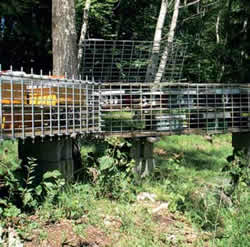 The primary goals of selective queen rearing: The primary goals of selective queen rearing:
• Assessing the quality of the breeding stock;
• Encouraging beekeepers to select and rear queens;
• Selling the reared genetic material in Slovenia and abroad.
The training of beekeepers in selecting and rearing queens includes the following:
• Learning about bee races, especially the morphological and
economically important characteristics of the Carniolan bee;
• Importance of establishing and preserving a pure bee race and
opportunities arising from special geographic and phenological characteristics;
• Health issues at breeding and mating stations;
• Beekeepers’ training and practical work in carrying out the selection and breeding programs.
The organization of rearing is important because expected results
can only be ensured by organized activity at all bee farms (in a wider area).
Bee farms that want to take part in the selection and breeding program
should have at least 20 bee colonies. This represents the minimum number of bees to enable successful selection.
• Selection is conducted according to a prepared program, encompassing:
• Evaluation of racial and other characteristics;
• Following the disease-control criteria.
• Queen rearing takes place at a breeding station using standard methods.
• For queen mating, existing mating stations are used. Moreover, new ones are being established in various parts of Slovenia.
• There must be ample opportunities for regular monitoring of bee
colony health at mating and breeding stations, as well as in surrounding areas or the entire rearing area.
• The reared stock is used for repopulation on bee farms with colonies
that are not pure-line. It is also used for continual regeneration in the entire rearing area.
• The spread of breeding stock in Slovenia and abroad.
Testing Queen-Rearing Conditions
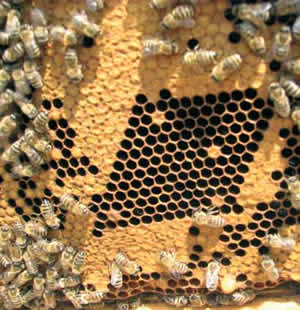 Carniolan queens are evaluated according to their most
prominent characteristics. These include the calmness of bees on
combs, non-aggressiveness, low swarming impulse, bee color (as one
of the breeding goals), colony development intensity, and the ability
to produce a sufficient honey yield. Two very important characteristics
are non-aggressiveness and cleaning behavior – that is, the ability
to remove dead bees from the combs.
This characteristic is being studied in bee colonies at the Agricultural
Institute of Slovenia and also being introduced into the practice
of approved breeding stations. Carniolan queens are evaluated according to their most
prominent characteristics. These include the calmness of bees on
combs, non-aggressiveness, low swarming impulse, bee color (as one
of the breeding goals), colony development intensity, and the ability
to produce a sufficient honey yield. Two very important characteristics
are non-aggressiveness and cleaning behavior – that is, the ability
to remove dead bees from the combs.
This characteristic is being studied in bee colonies at the Agricultural
Institute of Slovenia and also being introduced into the practice
of approved breeding stations.
Quality select breeding stock for reproduction can be obtained at all Slovenian queen-breeding and queen-mating stations.
Annually, up to 1,300 queens are taken from breeding stations to
test rearing conditions. Beekeepers that conduct anonymous testing generally have a higher number of bee colonies and are oriented towards intensive honey production. These are mostly contract-based migratory beekeepers that follow professional guidelines in testing queens.
Queens can be introduced to already-formed productive
colonies or to colonies set up in equal hives with a uniform frame
size. The colony strength must be sufficient for it to survive the
winter. During the winter season (from November to January), it is
essential for Varroa extermination to be conducted consistently in
all bee colonies in the bee yard because it is the most effective
at this time of the year. During evaluation, the colonies need to
stay together and must not be divided into groups at different locations.
All colonies in a bee yard must be tended to equally.
Varroa extermination and other activities (adding or removing
food or honey and carrying out preventive measures) must also be
uniform and recorded.
All the queens are tested for the calmness of their colonies, their
swarming impulse, the number of bees in their colonies, the total amount of honey yielded, and the degree of Varroa infestation.
Based on data on calmness, swarming impulse, the number of
bees in the colony, and the total honey yield obtained from these tests, the breeding value of the mothers of the tested queens is calculated. The breeding value of queens tested for honey yield is evaluated after removing all the queens that are statistically the most aggressive and have the strongest disposition
to swarm. To calculate the breeding value, a linear model
with fixed effects is used. Entering queens into the Carniolan Bee Breeding Register also enables us to take into account the genetic
relations between the queens.
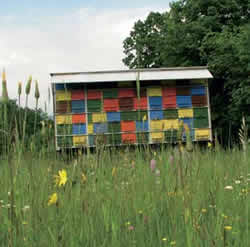 Queen breeders receive an annual notification of their queens’
test results. Before the breeding season, all the mothers of the queens not meeting the racial characteristics, or those that score below average in other characteristics, are excluded from the breeding stock. Queen breeders receive an annual notification of their queens’
test results. Before the breeding season, all the mothers of the queens not meeting the racial characteristics, or those that score below average in other characteristics, are excluded from the breeding stock.
As part of the beekeeping measures, queen-breeding stations have
begun carrying out direct testing of bee colonies. By monitoring the characteristics of colonies in rearing bee houses, the quality of the parent colony can be more reliably established.
Why Rear Pure-Line Queens?
Because individual races of the western honey bee exhibit
clear differences in their morphological and economically important
characteristics, one also expects discernable disparities within
an individual race. These are called local varieties or ecotypes. This becomes especially apparent if individual groups are
bred for long periods in isolated climatic and geographic environments.
Beekeepers that breed bee colonies from different areas have
varying experiences with them in otherwise identical geographic and foraging conditions. Thus, for example, bees from the Pannonian region tend to exhibit weaker abilities to utilize forest forage. Bees originating from different geographic areas have varying success rates in pollinating alfalfa in the same location.
Equally, the development intensity of bee colonies from different
geographic and climatic environments varies. Based on the Carniolan bee’s performance, assessed in dissimilar environments by beekeepers in the course of their work, its adaptability needs to be preserved as well.
An important task and duty of beekeepers is also preserving the
population diversity of Carniolans in different geographic areas of Slovenia.
Ensuring the Rearing of Pure-Line Queens
and Queens Fertilized by Natural Selection
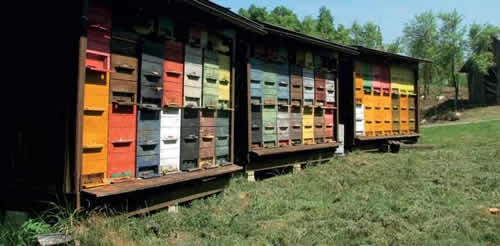 Controlled mating of queens takes place at isolated mating stations.
The drones there are of controlled origin, the progeny of one or more queens. Queens produced through controlled mating are pure-line queens. In contrast, free mating of queens takes place at breeding stations where complete control over the origin of the local drones is not guaranteed. Queens produced in this way are queens fertilized by natural selection. Controlled mating of queens takes place at isolated mating stations.
The drones there are of controlled origin, the progeny of one or more queens. Queens produced through controlled mating are pure-line queens. In contrast, free mating of queens takes place at breeding stations where complete control over the origin of the local drones is not guaranteed. Queens produced in this way are queens fertilized by natural selection.
To rear pure-line queens, drone-rearing colonies must be selected at
the mating station. For this purpose, pure-line queenmating stations are being set up in various parts of Slovenia (Gregorc et al. 2008). A numerous and dispersed population ensures preservation of the race with varieties in certain geographic areas (e.g., the Upper Sava Valley, the Logar Valley, the Pannonian area, and White Carniola).
Breeding Activities Connected with Selecting Parent Colonies
The laboratory conducts measurements of worker bee samples from
bee colonies that breeders suggest for parent colonies based on tests and analyses. The role of the three-member work group, made up of representatives of the PRO and DPO, is to assess the suitability of breeding stations and to confirm parent colonies on an annual basis. The work group examines around 30 breeding stations each year. The planned annual rearing yield is about 24,000 queens. The final decision on the parent colonies is made by the technical service.
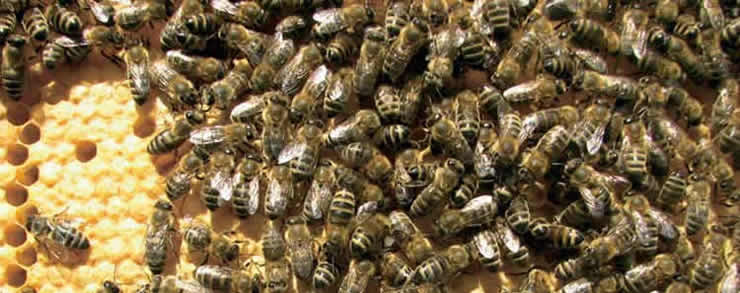
The queens of selected parent colonies generally already
have a breeding registration number; if not, they are assigned
one. Breeders receive labels so that each queen reared at the approved
station can be labeled. Reared queens are also entered
into the Pure-Line
The health status of bee colonies at breeding stations is
checked by professionals at the National Veterinary Institute of
the Veterinary Faculty of the University of Ljubljana, who issue
an
appropriate certificate. The greatest attention is paid to discovering
American foulbrood. All colonies at the queen-breeding station
are examined. Rearing is only possible if the station is not
in a detected infection zone. Every beekeeper has an important
role to play by reporting a possible infectious disease to the
technical service.
The dying out of bee colonies at a queen-breeding station
has more long-term effects and more negative consequences
than at other bee farms. The rearing apiaries at breeding stations
generally contain selected colonies (years of labor are put into
the selection). When these colonies are lost, breeding stock that
would otherwise contribute to advances in rearing progress is
also lost. When bee colonies die out at queen-breeding stations,
this undermines breeding developments. Many years of monitoring
characteristics and conducting selections will be required
to achieve the same level again.
Aleš Gregorc
|
